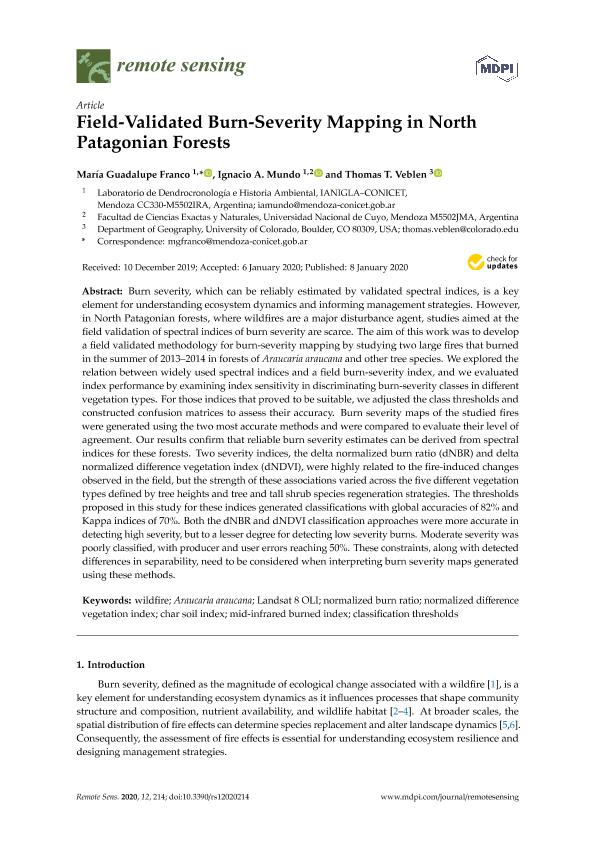Mostrar el registro sencillo del ítem
dc.contributor.author
Franco, María Guadalupe

dc.contributor.author
Mundo, Ignacio Alberto

dc.contributor.author
Veblen, Thomas T.
dc.date.available
2021-10-07T14:35:02Z
dc.date.issued
2020-01
dc.identifier.citation
Franco, María Guadalupe; Mundo, Ignacio Alberto; Veblen, Thomas T.; Field-validated burn-severity mapping in North Patagonian forests; Molecular Diversity Preservation International; Remote Sensing; 12; 2; 1-2020; 1-18
dc.identifier.issn
2072-4292
dc.identifier.uri
http://hdl.handle.net/11336/143114
dc.description.abstract
Burn severity, which can be reliably estimated by validated spectral indices, is a key element for understanding ecosystem dynamics and informing management strategies. However, in North Patagonian forests, where wildfires are a major disturbance agent, studies aimed at the field validation of spectral indices of burn severity are scarce. The aim of this work was to develop a field validated methodology for burn-severity mapping by studying two large fires that burned in the summer of 2013-2014 in forests of Araucaria araucana and other tree species. We explored the relation between widely used spectral indices and a field burn-severity index, and we evaluated index performance by examining index sensitivity in discriminating burn-severity classes in different vegetation types. For those indices that proved to be suitable, we adjusted the class thresholds and constructed confusion matrices to assess their accuracy. Burn severity maps of the studied fires were generated using the two most accurate methods and were compared to evaluate their level of agreement. Our results confirm that reliable burn severity estimates can be derived from spectral indices for these forests. Two severity indices, the delta normalized burn ratio (dNBR) and delta normalized difference vegetation index (dNDVI), were highly related to the fire-induced changes observed in the field, but the strength of these associations varied across the five different vegetation types defined by tree heights and tree and tall shrub species regeneration strategies. The thresholds proposed in this study for these indices generated classifications with global accuracies of 82% and Kappa indices of 70%. Both the dNBR and dNDVI classification approaches were more accurate in detecting high severity, but to a lesser degree for detecting low severity burns. Moderate severity was poorly classified, with producer and user errors reaching 50%. These constraints, along with detected differences in separability, need to be considered when interpreting burn severity maps generated using these methods.
dc.format
application/pdf
dc.language.iso
eng
dc.publisher
Molecular Diversity Preservation International

dc.rights
info:eu-repo/semantics/openAccess
dc.rights.uri
https://creativecommons.org/licenses/by-nc-sa/2.5/ar/
dc.subject
ARAUCARIA ARAUCANA
dc.subject
CHAR SOIL INDEX
dc.subject
CLASSIFICATION THRESHOLDS
dc.subject
LANDSAT 8 OLI
dc.subject
MID-INFRARED BURNED INDEX
dc.subject
NORMALIZED BURN RATIO
dc.subject
NORMALIZED DIFFERENCE VEGETATION INDEX
dc.subject
WILDFIRE
dc.subject.classification
Ecología

dc.subject.classification
Ciencias Biológicas

dc.subject.classification
CIENCIAS NATURALES Y EXACTAS

dc.title
Field-validated burn-severity mapping in North Patagonian forests
dc.type
info:eu-repo/semantics/article
dc.type
info:ar-repo/semantics/artículo
dc.type
info:eu-repo/semantics/publishedVersion
dc.date.updated
2021-09-06T20:06:10Z
dc.journal.volume
12
dc.journal.number
2
dc.journal.pagination
1-18
dc.journal.pais
Suiza

dc.description.fil
Fil: Franco, María Guadalupe. Consejo Nacional de Investigaciones Científicas y Técnicas. Centro Científico Tecnológico Conicet - Mendoza. Instituto Argentino de Nivología, Glaciología y Ciencias Ambientales. Provincia de Mendoza. Instituto Argentino de Nivología, Glaciología y Ciencias Ambientales. Universidad Nacional de Cuyo. Instituto Argentino de Nivología, Glaciología y Ciencias Ambientales; Argentina
dc.description.fil
Fil: Mundo, Ignacio Alberto. Consejo Nacional de Investigaciones Científicas y Técnicas. Centro Científico Tecnológico Conicet - Mendoza. Instituto Argentino de Nivología, Glaciología y Ciencias Ambientales. Provincia de Mendoza. Instituto Argentino de Nivología, Glaciología y Ciencias Ambientales. Universidad Nacional de Cuyo. Instituto Argentino de Nivología, Glaciología y Ciencias Ambientales; Argentina
dc.description.fil
Fil: Veblen, Thomas T.. University of Colorado; Estados Unidos
dc.journal.title
Remote Sensing
dc.relation.alternativeid
info:eu-repo/semantics/altIdentifier/url/https://www.mdpi.com/2072-4292/12/2/214
dc.relation.alternativeid
info:eu-repo/semantics/altIdentifier/doi/http://dx.doi.org/10.3390/rs12020214
Archivos asociados
